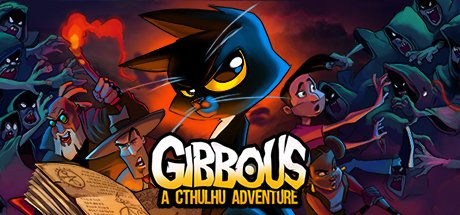There’s only so much I know on the subject of using social media to promote indie games. One of the ways I’ve learned is by examining indiedevs who have done it successfully and looking more closely at how they managed it.
That’s why I asked Stuck In Attic, the developers of Gibbous: a Cthulhu Adventure on how they managed to grow an audience to help make a commercially successful game.
Gibbous: A Cthulhu Adventure is a point-and-click adventure game made by Transylvanian-based studio Stuck in Attic inspired by Lovecraft’s Cuthulu mythos. The game features hand-drawn animation, a cosmic-horror flavored comedy, and a sarcastic talking cat. Stuck in Attic currently has 3,732 Followers on Twitter and 1,169 followers on Instagram. The release was so successful that the team have started Kickstarter funding for their next project: Near-Mage.
Here’s how this three-person gamedev team built an audience that paved their road to success.

1. How did you seed your first followers? Where did they come from? How did they find you?
The core of our followers definitely came from Kickstarter. We had been posting about the game occasionally on genre-dedicated forums, but the Kickstarter campaign was the first time it felt like suddenly there was a spotlight on our game, and people not only talked about it, but backed it, too. The organic discovery on Kickstarter was better than we had expected – there are a lot of people that just hang out seeing what cool new projects crop up. We did have people waiting for us to launch the campaign that were in already, but it really felt like crowdfunding is what crystallized our fan base.
2. What goals did you have for your social media marketing when you first started out? Did you have anything specific you wanted to accomplish? What was the time frame? What were your parameters for success?
To be quite honest, we didn’t really have even basic notions of marketing when we started out, just an intuitive need to get the game in people’s faces, get them excited about it. We sheepishly started by posting some gifs of the game on a couple of forums that got people interested, and that’s when it clicked – showing off Gibbous’s visuals and animations was the way to go. We come from traditional, frame-by-frame animation, which is not necessarily a staple of indie 2D games – so we constantly showed that off, plus the elaborate background art. Plus we had a talking cat, and everyone knows the internet is for cats.
We worked on our 3-room vertical slice demo in the year that we built up to our Kickstarter campaign, and we made sure we’d put in as much impressive visual stuff as possible, because we realized that was what got likes and follows on social media. If they involved Kitteh, the feline star of the game, they did even better. I think the commitment to polished artwork, plus an art style that is vaguely reminiscent of the great Lucas Arts games of the 90s, really helped communicate to our target audience that yes, we enjoy the same things as they do, and yes, Gibbous is the game they should be playing.
3.I see that Stuck in Attic/Gibbous is active on both Twitter and Instagram. Why those platforms in particular? What was the thinking there?
We sort of intuitively drifted towrards Twitter and Instagram because they’re some of the most visually-driven platforms, and visuals are our most valuable marketing asset. To be honest, we’re probably not leveraging Instagram as much as we could, because of the hassle of having to upload art made on a PC via mobile. Twitter also has a strong adventure game community – there are specific hashtags like #AdventureGameFriday where devs and fans help each other discover new projects, it’s pretty neat. There’s probably a lot more we could be doing social media-wise, but there’s only so many hours in day…
4. How did you go about planning your social media strategy? How did that strategy change as time went on?
It all happened a bit haphazardly and just based on instincts – our only plan was to have as much visual ammo as possible, and try not to let a week pass without posting something that catches the eye. It became tougher and tougher as the years passed, because you can only show so much before entering spoiler territory with narrative games, but you do need to remember that not everyone sees your every tweet, so posting the same piece of art twice is not necessarily a bad thing. I can’t say that the strategy’s changed much – it’s a bit easier now, in fact, because since it’s been more than a year that the game’s been out, I finally feel fine posting stuff that constitutes minor spoilers, but looks good.
5. What experiments did you try to optimize your profiles? What worked? What didn’t?
Maybe it’s weird, but the most experimentation took place within Steam’s complicated back-end, trying to figure out how to best put its organic discovery to use. External traffic from social media is nice, but there was so much within the actual platform we were preparing to sell on that we hadn’t fully put to use, such as tags – that was the kind of stuff that really made the difference. I wrote a couple of articles about how to optimize your Kickstarter and Steam presence, and I still have a couple of drafts that I can’t seem to find the time to finish. I believe you need to pay close attention to every website that can help your game, be it where you sell it or where you advertise it. I think it’s this wide-spread approach that helped us a lot. When you’re in a niche genre like we are, visibility is an uphill battle, and you need to make all shots count.
6. How did you identify your game’s brand voice? When I browse through your Twitter I see that your posts are very tounge-in-cheek, spunky etc. Was that deliberate, or is that just how your social media’s personality and voice took shape as time went on?
Well, we made a fun comedy game that’s a send-up of cosmic horror, so I guess I just naturally drift in that general direction when posting. Marketing yourself can feel a bit cheesy and try-hard at times, and I’m constantly wary of sounding like a self-promoting robot, so I do my best not to take myself too seriously on the socials.
I’ve also realized that both gamers and fellow devs love insights into how we make stuff, how our game’s doing sales-wise, where we succeed and where we fail, so lately I’ve been trying to tweet out that kind of info. It’s fun for some, informative for others, and maybe even inspiring. We’re a niche game with a tiny following, but we seem to attract good people, and I find it very satisfying to do my best to keep whatever we put out there either entertaining or interesting. My one rule is to keep “personal” posting to a minimum, and if I do do it it’s usually because I think our followers might relate. All in all, trying to respect our followers’ feeds and not fill it with nonsense.
7. Final question: Favorite Lovecraft story and why?
The Shadow over Innsmouth, no doubt, and the reason is a video game. Playing Call of Cthulhu Dark Corners of the Earth was such a revelation for me, because somehow Headfirst somehow managed to present the story’s setting and characters exactly as I had imagined them. That’s what made Shadow become my favorite Lovecraft story, and a big part of the reason we made Gibbous.
Please support the Near-Mage Kickstarter, and buy Gibbous: A Cthulhu Adventure available for $19.99 on Steam. Be sure also to follow them on Twitter and Instagram.

